Cases
The Cases of Lethal Violence in Veracruz 2010-2016
By María Eloísa Quintero
This title summarizes the relevant facts, main threats, and scope of ministerial investigations into 20 individual cases of disappearance and lethal violence against journalists in Veracruz during the period from 2010 to 2016.
Concrete hypotheses regarding the motives behind these murders are listed based on a thorough review of documentary sources and interviews.
Detailed information is provided for each case, including the circumstances surrounding the disappearance and death, prior threats, and investigations.
Given the context of journalism in Veracruz during those years, three general hypotheses are suggested that are possible and applicable to all cases of lethal violence:
1) due to «crossfire» resulting from territorial disputes of organized crime in the indicated area and timeframe;
2) due to the publication of a note touching on specific interests, whether these notes are identified or still unidentified;
3) because someone «put» the victim, as it was called in the local slang, meaning pointed to another to save oneself, save another, or for reasons of external or personal interest.
Cases
Case 1
Noel López Olguín
read
Cases 2 & 3
Miguel Ángel López Velasco y Misael López Solana
read
Case 4
Yolanda Ordaz de la Cruz
read
Case 5
Manuel Gabriel Fonseca
read
Case 6
Regina Martínez Pérez
read
Cases 7, 8 & 9
Guillermo Luna Varela, Gabriel Huge Córdova y Esteban Rodríguez Rodríguez
read
Case 10
Víctor Manuel Báez Chino
read
Case 11
Miguel Morales Estrada
read
Case 12
Sergio Landa Rosado
read
Case 13
Gregorio Jiménez de la Cruz
read
Case 14
Moisés Sánchez Cerezo
read
Case 15
Armando Saldaña Morales
read
Case 16
Juan Atalo Mendoza Delgado
read
Case 17
Rubén Espinosa Becerril
read
Case 18
Anabel Flores Salazar
read
Case 19
Manuel Torres González
read
Case 20
Pedro Tamayo Rosas
read
Case 1: Noel López Olguín
Empirical reporter, 45 years old. Contributor to at least four newspapers: La Verdad, Noticias de Acayucan, La Verdad de Jáltipan and El Horizonte de Nanchital.
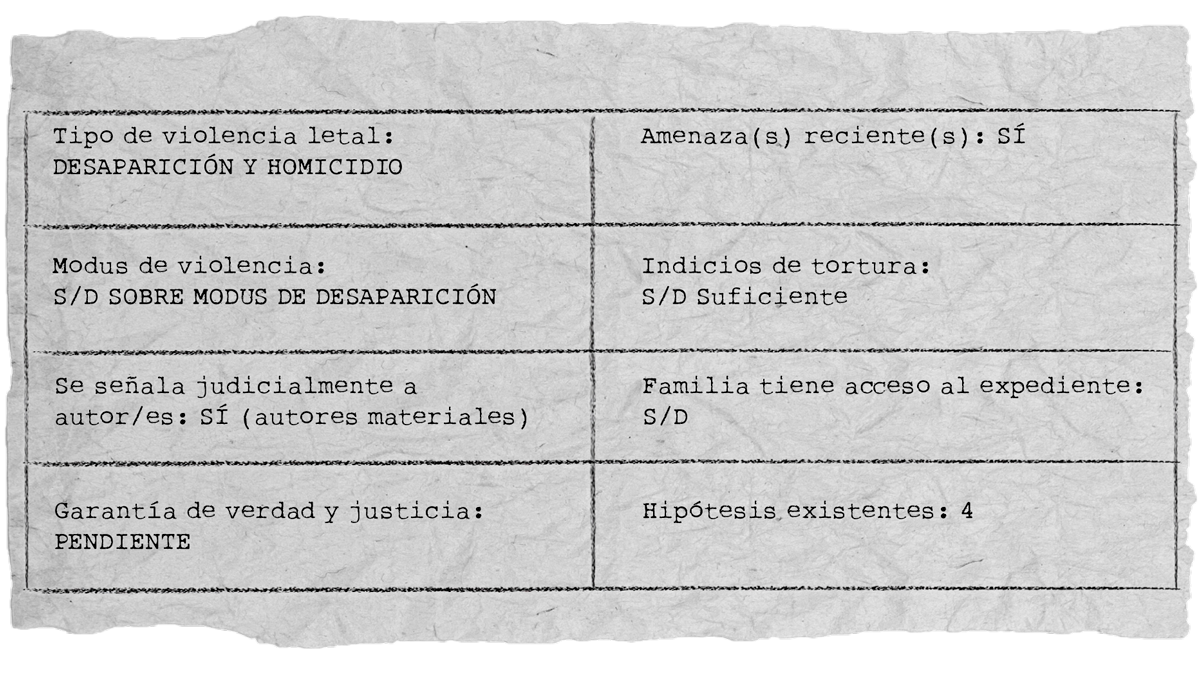
Facts
On the morning of March 8, 2011 he received a phone call while he was having breakfast, he told his wife that he would run a couple of errands and would be back in the afternoon; he never returned. The next day his car was found on the Soteapan highway.
According to what the authorities told the Committee to Protect Journalists (CPJ), López Olguín was kidnapped by armed men in two vans. Jesús Lemus’ book states that: “In the morning he had coffee with some friends. In that meeting he would have commented for the last time about the threats he was being subjected to by members of organized crime; he said that they were members of Los Zetas but that they were at the service of the mining company Gold Group Mining Inc. and that in some way they were the ones looking after the interests of that economic group”.
His remains were found 3 months later in a clandestine grave in the Malacate ejido, according to information provided by Alejandro Castro Chirino, alias El Dragón, who upon being arrested confessed to the murder of the journalist, gave indications of the place where the body had been buried and also revealed that he had participated in other murders and kidnappings.
Threats
He had received various intimidations and threats, among them from federal deputy Miguel Ángel Morales Cortés. Colleagues said that once he met him and told him “pinche perro, aquí te voy a matar” (fucking dog, here I am going to kill you) and showed him the machete he was carrying in his hand. Also the mayor of Jáltipan, José Antonio Lázaro Sosa, once threatened to kill him and on another occasion shouted at him in front of the offices of the newspaper La Verdad, accompanied by official patrol cars. The journalist was also an activist and militant of the PRD – a party with a minority presence at that time and in that region. He covered issues related to insecurity, organized crime and corruption. In the aforementioned book, the threats from the Zetas are mentioned.
Investigation, process and hypothesis
The official hypothesis rests on the authorship of Castro Chirino, originally from Tonala, Chiapas, presumably from the Jalisco Cartel – New Generation (CJNG). Three coincidences made it possible to arrive at this conclusion: first, the authorities received an anonymous tip, which led to the arrest of the alleged murderer during a patrol by SEDENA. Secondly, Castro Chirino confessed to the murder of the journalist, as well as his participation in the murders of two commanders and a woman who accompanied him: one from the Cosoleacaque Police Corporation, the other from the Intermunicipal Police. When testifying, he also attributed to himself the death of three other municipal police officers and the kidnapping of a gynecologist doctor, who was kidnapped on May 26 of that year in Coatzacoalcos.
Thirdly, when he was arrested, despite the fact that months had passed since the kidnapping of the journalist, Castro Chirino had with him the camera owned by Noel López Olguín.
There are other hypotheses in relation to his murder, two directly related to his professional activity: 1) in his articles “he had been against politicians and drug traffickers”, among them municipal presidents. 2) The murder is related to his political and social activism. He was interested in community problems, such as corruption and insecurity; he had denounced abuses by authorities and members of organized crime. 3) He touched particular interests; he gave voice to the indigenous communities dispossessed by the “Caballo blanco” project.
Cases 2 & 3: Miguel Ángel López Velasco y Misael López Solana
Miguel Ángel López Velasco (who signed columns and was known as Milo Vela), 55 years old, reporter, columnist, editor. More than 30 years practicing journalism, many of them in Notiver; in that newspaper he coordinated the Sucesos section, of which most of its members were murdered: Gabriel Huge, Yolanda Ordaz, Misael López and Guillermo Luna. During a previous period, Milo Vela collaborated in other media: he was in Telever (Televisa Veracruz) and in El Diario de Xalapa as chief police correspondent, while he contributed to TV Azteca with reports.
Misael López Solana, 22, younger son of Milo, police photographer for Notiver. He also worked in the social communications office of the Boca de Río city hall.
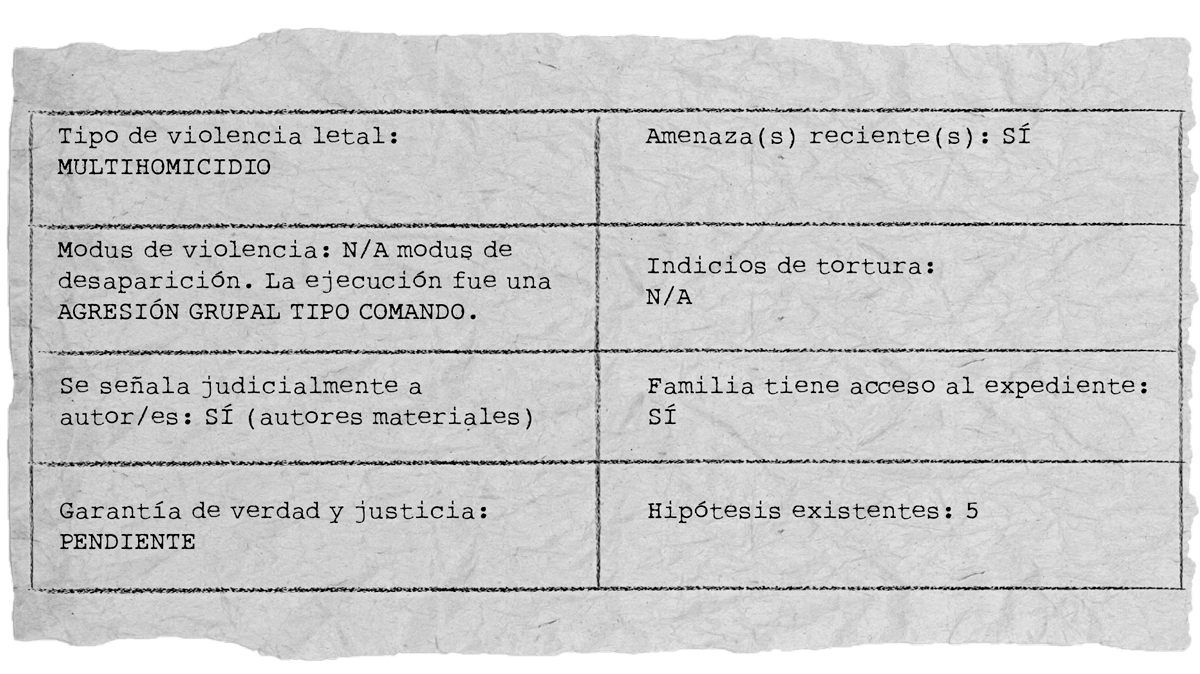
Facts
On June 20, 2011, armed men forced the lock and entered the home of the Velasco Solana family in the Fernando López Arias neighborhood of Veracruz, located 5 blocks from the intermunicipal police headquarters. Miguel Angel Velasco, his wife Agustina Solana and their youngest son Misael were murdered. According to the forensic expert’s report, the multiple homicide occurred between 05:54 and 06:06 and was executed by at least 6 people. In the place there were found gunshells of different calibers that according to the forensic analysis fired 33 times against the victims.
Threats
Milo Vela documented and denounced cases of corruption, insecurity, links between police and criminals, and irregularities in the government of Javier Duarte. On one occasion, alleged drug traffickers deposited on the front door of Notiver the head of a person said to be a member of Los Zetas, supposedly executed the day before, accompanied by the message “here we leave you a gift… so many heads will roll, Milo vela knows it and many more, a hundred heads will roll for my dad. Sincerely, the son of Mario Sánchez and the Gente Nueva”. Milo received multiple intimidations and threats. For this reason, at some point he was sheltered (he moved away from the environment and the region) as a precaution.
Investigation, process
The Veracruz Attorney General’s Office (PGJE) has identified Juan Carlos Carranza Saavedra, alias El Ñaca, as the alleged perpetrator. The former head of the Special Prosecutor’s Office for Attention to Crimes Committed against Freedom of Expression (FEADLE), Laura Borbolla, when appearing before the Permanent Peoples’ Tribunal said that the main line of investigation in this case is related to organized crime although police participation is not ruled out. She said that: “a tactical group with a certain form of police-type execution or training with these characteristics was the one that broke into the journalist’s home to execute him” (…) “The suspicion was that a person who had been a police commander had migrated to work for one of these groups and was exposed in a veiled manner by Miguel and that this was the reason for the issue”.
As reported by Notiver, in the days following the multihomicide, Carranza phoned the newspaper and assured that he had not perpetrated the crime and that Gilberto Osorio, alias El Gordo Osorio, an agent of the Judicial Police, was responsible.
Hypothesis
There are at least 5 hypotheses about the motives of the attack against Milo Vela and his family: it is mentioned that the motive was robbery; also that it was due to links with organized crime, anger of a certain state official, differences with mining consortiums, among other possible reasons.
However, officially it is still said that Juan Carlos Carranza Saavedra, the Ñaca, was the one who decided to silence him: the PGJE concluded that he was the intellectual and material author of the murder; the motive was not very clear.
Case 4: Yolanda Ordaz de la Cruz
Journalist, 48 years old. He worked at the Notiver newspaper along with Milo Vela. She headed the Sucesos section -police news- and he was its editor.
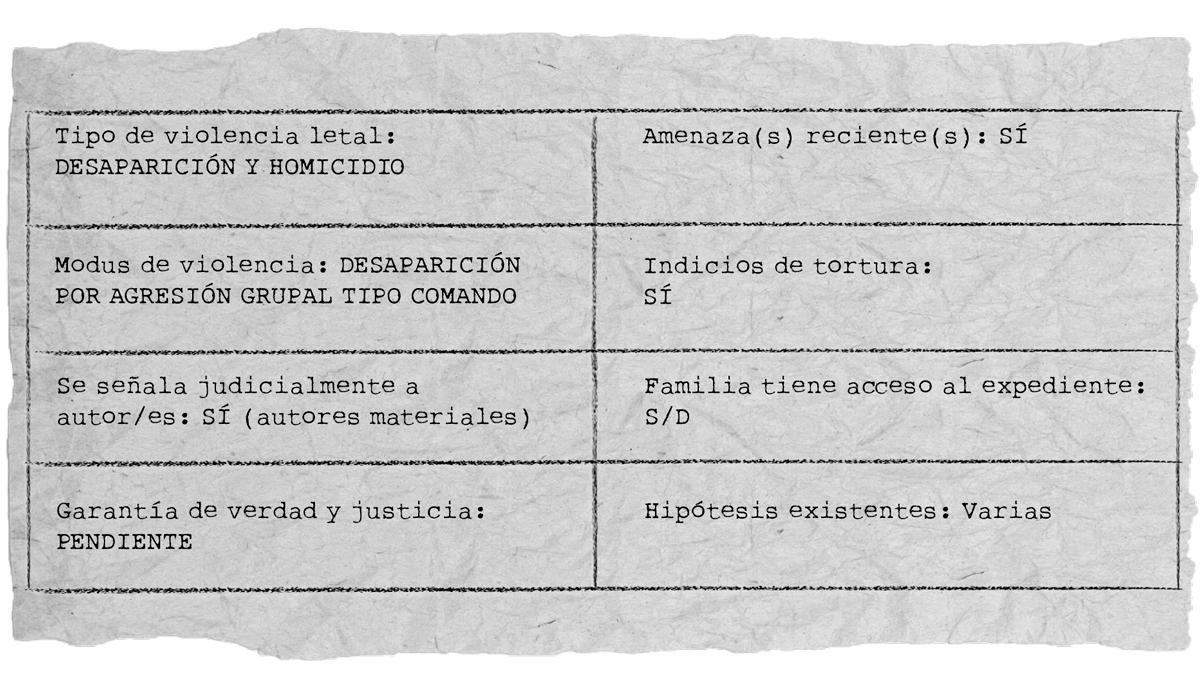
Facts
July 24, 2011 was the last day that her companions and family saw her alive. In the early morning of the 26th of that month her body was found decapitated and with signs of torture. This happened a month after the murder of her immediate boss at Notiver, Miguel Ángel López Velasco.
His head was left in front of the facilities of the Imagen del Golfo newspaper and the MVS radio station in Boca del Río, next to him was a sign with the phrase “friends also betray: Sincerely Carranza”. It was the first time in those years that such a level of violence and exposure of the remains of a journalist was registered, with such a communicative staging.
Threats
The Zetas and the Gulf Cartel were fighting for control of trafficking territory and activities. Violence had affected the journalistic profession, especially those who covered the “nota roja” (police). Yolanda had learned to live with danger; she had received several letters with death threats.
Investigation, process
When the body was found, the head of the State Attorney General’s Office, Reynaldo Escobar Pérez, held a press conference and made it clear that “… these types of deplorable events have nothing to do with the exercise of the profession of journalist, but rather with the relationship that, perhaps circumstantially, some communicators establish with the criminal cartels, which the federal and state authorities fight every day and in all areas”.
A few days later, on August 2, during an operation carried out by SEDENA in the La Pochota neighborhood, a confrontation took place in which two alleged members of a criminal group were killed; among their belongings was found the reporter’s official identification. It should be noted that in the investigation of the case of Yolanda Ordaz, as well as in Case 1 (Noel López Olguín):
(a) the alleged perpetrators are detained/arrested for acts unrelated to the investigation (in the first case, an anonymous complaint and in the second a general anti-drug trafficking operation);
b) at the time of their apprehension they were in possession of their alleged victims’ belongings.
In turn, the person who supposedly signs the note that appeared next to the body -Carranza- is that former police officer Juan Carlos Carranza Saavedra, who according to the ministerial investigation was the material and intellectual author of Case 2, that is, the case of the multi-murder in which Milo Vela died.
Hypothesis
The official hypothesis indicates that the homicide was perpetrated by members of organized crime and that it was not related to journalistic work. This was stated by the State Attorney General, Reynaldo Escobar, who said that Ordaz’s murder was a settling of scores between criminal gangs.
Notiver – the newspaper where the journalist worked as well as the victims of cases 2 (Milo Vela) and 3 (Misael Velasco Solana) – requested the resignation of the official as a result of the statements he made about Ordaz. The newspaper stated: “We strongly reject the accusation and the accusation as unjust, irresponsible and foolish, and we demand a public apology and the resignation of Reynaldo Escobar, who should also be investigated and prosecuted”.
Regina Martínez (a journalist who was later murdered, case 6) published in Proceso an article about Notiver’s demand, an article that reveals the tensions between the media and part of the government.
A few days later, the Veracruz attorney general resigned. He did so the day after the discovery of 32 corpses in three safe houses in Boca del Río, on October 6, 2011. These bodies were added to 35 others that the previous month had been dumped on the busiest avenue of the same Veracruz city.
Case 5: Manuel Gabriel Fonseca
Empirical journalist, 19 years old. He collaborated in Diario de Acayucan and El Mañanero.

Facts
He was last seen on Saturday, September 17, 2011 when he left for work to go to the offices of El Mañanero, where he met his boss and told him he was going out to eat some tamales. That night he did not come to sleep at his family’s home. His father went out to look for him. He did not find him nor did he have any communication with him again; they dialed his phone but it went straight to voicemail.
According to members of the Association of Journalists of Acayucan, the complaint for the disappearance of the reporter never made progress and even elements of the now defunct Attorney General’s Office (PGJ) hindered the application of genetic tests to the parents of Cuco, as his friends called Gabriel.
In 2015 his colleagues denounced that the prosecutor’s file was closed. A protest was led by the CEAPP: “through the official letter CEAPP/SE/088/2015, the CEAPP requested to know if the FGE had carried out genetic profile comparisons with the samples collected from the family members, on what dates it had done so and what were the results obtained. Months passed and there was no response. That same year, Prosecutor Bravo Contreras said: ‘We are already looking into other legal avenues and a review of the file… There are flagrant omissions by the Prosecutor’s Office in the case’”.
No progress has been made in the investigation or prosecution.
Hypothesis
There are unofficial versions and all refer to the night of the celebration of September 15, 2011 in the Municipal Palace of Acayucan. Apparently, at that party Manuel Gabriel spoke with other people about sensitive issues such as organized crime and revealed information that could have angered third parties. Oral accounts of that night add that Fabiola Vázquez Saut, then mayoress, and Víctor Acrelio Alegría Antonio, police commander, were present at the time and even interrupted and controlled the journalist’s comments.
Little is known about what happened afterwards. A witness interviewed by the press said that he had seen him together with a man named Andres Miguel Palmar, nicknamed El tegogolo, at the Bodega Aurrera supermarket and detailed that they both got into a car. Another source said that some colleagues saw him in the downtown area of the city and also said that they were located when they allegedly boarded a truck in the direction of Coatzacoalcos. There is no evidence that all this has been investigated or corroborated.
On the tenth anniversary of his disappearance, in an interview his father said “they were already waiting for him at the exit. A black van. There were about three or four of them. And they grabbed him and called him, they pulled him in, they pulled him in, he didn’t want to get in but they pulled him in.”
All of these pre-existing hypotheses link the disappearance to something Gabriel heard and/or said. They also suggest that members of criminal organizations were the ones who disappeared him.
Case 6: Regina Martínez Pérez
Journalist, 48 years old. Studied journalism at the Universidad Veracruzana. Collaborated in several media: TV Más, El Sol de Chiapas, Número Uno, La Jornada and Proceso.
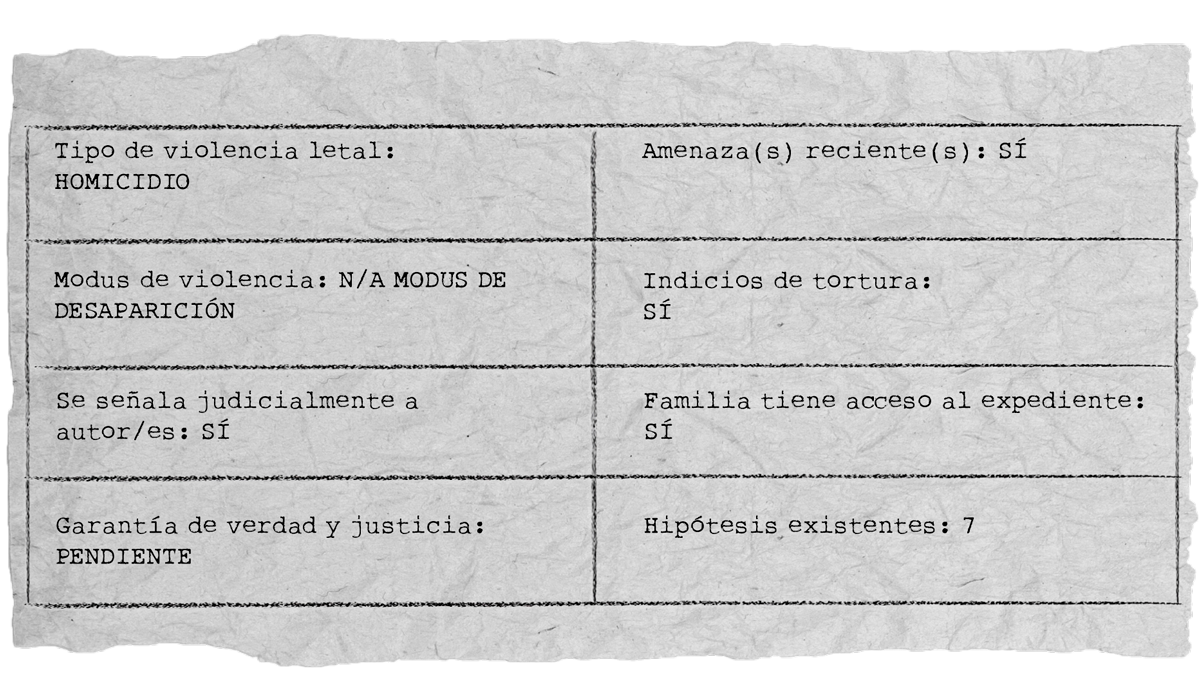
Facts
On Saturday, April 28, 2012, she was found dead in the bathroom of her home; she had bruises on her face and body, as well as signs of strangulation and asphyxiation with a bath jargon. Her computer, cell phones -according to one source- and two cassettes -according to another- were stolen from the place.
It was one of the murders with the greatest repercussions, not only in Veracruz but also nationally and internationally, not only because he was a correspondent of Proceso magazine but also because of his career. Due to the pressure generated by this case, the idea of creating the State Commission for the Attention and Protection of Journalists (CEAPP) began to take shape, which finally came into being in December of that year.
Threats
He denounced and documented all kinds of abuses by politicians as well as private companies and corruption issues. He covered the most controversial and important cases that occurred in Veracruz and had national transcendence or sometimes reached it thanks to his notes and reports.
He often received intimidating phone calls; he also received threats and threats of lawsuits. For this reason she lived a reserved life; her colleagues and friends say that few people entered or shared with Regina in her home. Neighbors, workers and other witnesses testified before the ministerial authorities that the journalist was a very discreet and isolated person with whom they had little contact.
Before her murder she had a security incident. In December 2011, when she returned from visiting her family, Regina realized that someone had entered her home. The house was in order, except for the bathroom. There the soap boxes were open and the air was still damp, as if someone had just used the shower, as a message of intrusion. She was killed in that bathroom, 4 months later.
Investigation and process
From the very beginning, the PGJE of Veracruz ruled out that Regina’s murder was related to her journalistic work; it assured that the motive for the crime was robbery and that everything happened as a consequence of an alleged conflict of passion. There are indications that the journalist was subjected to torture but this fact was minimized in the case file.
The ministerial line of investigation is based on the confession of the alleged perpetrator, Jorge Antonio Hernández Silva, alias “El Silva”, who claims to have acted in the company of José Adrián Hernández Domínguez, alias “El Jarocho”. Silva stated in the case file that the two had gone to the journalist’s house to have a drink and that he had a “couple’s” argument with her. However, the fingerprints collected at the crime scene and the blood samples do not match.
The day after giving his confession, Hernández Silva recanted; he claimed that he had been tortured and threatened.
It is important to mention that Hernandez Silva was a man whom Regina Martinez had known for several years since he had published his story as a young victim of various forms of violence, HIV carrier with no access to health care and living in a street situation. She helped him then and presumably continued to help him as much as she could.
Hypothesis
After the investigation and analysis of documentary and live sources, it was found that there are at least 7 hypotheses about the motives for her murder; all linked to her journalistic activity.
According to a live source (witness), Regina’s death is related to a publication that appeared in the magazine Proceso: an article about alleged links with organized crime of two strong figures in Veracruz politics who at the time aspired to be deputies. The text did not bear Regina’s signature, but it is presumed that she was the one who provided the information to the colleagues in the capital who signed it.
One media mentions that days before her death, Regina had denounced the alleged involvement of nine policemen in a drug trafficking affair and that triggered the lethal aggression. Others point out that she had planned to reveal her investigation on the disappearance of thousands of people in Veracruz; or that her murder had to do with other publications she had made, such as the case of Ernestina Ascencio, an indigenous woman from the Sierra de Zongolica who died after a gang rape and an attack by members of the Mexican Army.
A witness says that Regina “was getting involved in the behind-the-scenes of the justice system… everything indicates that someone from the State sent her to kill her, to give her a little warm-up and they overplayed their hand”. Finally, a source states that another possible motive is that Regina was one of the few journalists who publicized the actions of the so-called Pact for a Veracruz Free of Toxic Mining, in which social organizations and representatives of indigenous communities denounced the devastating presence of transnationals in mining projects both in the area of Perote and in the region of Los Tuxtla.
In spite of all the above, the criminal case follows the hypothesis of robbery and reproaches the aforementioned perpetrators for this crime and the resulting aggravated homicide.
Cases 7, 8 & 9: Guillermo Luna Varela, Gabriel Huge Córdova y Esteban Rodríguez Rodríguez
Guillermo Luna Varela, empirical photojournalist, 21 years old. He collaborated with Notiver, Veracruz News and Diario Cardel.
Gabriel Huge Córdova, empirical photojournalist, 37 years old. He collaborated in El Sur and Notiver. He also had his own ventures at the same time: an Internet café, a video store and a laundry, among others.
Esteban Rodríguez, empirical photojournalist, 30 years old. He collaborated in Diario AZ, Imagen, Tv Azteca and Notiver.

Facts
They were last seen on May 2. In the morning, along with other colleagues, they were covering a traffic accident in the port of Veracruz. According to the testimony of Isabel Luna, several reporters, among them her brother Guillermo Luna, were covering a car crash that occurred that day on the streets of González Pagés and Juan Enríquez. Several colleagues went to the scene of the accident in the same car. Journalist Juan Carlos Parra noticed that Guillermo did not return with them in the car and immediately asked for him. Franco Cardel, reporter for the AZ newspaper replied that Guillermo “had gone on an errand”.
However, later Huge and Luna returned to their home, from where they left a little later each one on their own and did not return.
Gabriel Huge knew he was in danger. According to a source, hours before his death he told a friend that he was going to a delicate appointment.
He told him “if I don’t come back in 2 hours, I’m entrusting my daughter to you”. It is presumed that they were summoned to a dangerous appointment, possibly the meeting took place in the city of Cardel, half an hour from the port.
On the morning of the following day, May 3, 2015, their remains, along with those of Irasema Becerra, were found in plastic bags that were thrown into a sewage canal known as La Zamorana, in the Las Vegas 2 subdivision of Boca del Río. They were tortured and dismembered.
Threats
Gabriel Huge had previously received threats, allegedly from organized crime and police sources. The three photographers were included in a list of 13 names of Veracruz journalists who had received death threats. The list circulated through social networks since mid-2011 and was reported to some international organizations. They, like journalist Esteban Rodríguez, had left the state the previous year because of threats.
Investigation and prosecution
The Veracruz Prosecutor’s Office, through a statement, referred that due to the characteristics of the crime, the participation of organized crime in the commission of the murders was presumed. The hypothesis of the file relates that the 3 reporters and the publicist were summoned to a place, then kidnapped and murdered.
This case was solved with the arrests of two alleged members of the Jalisco Cartel – New Generation. One of the detainees was found with Irasema’s photo, authorities reported. SEMAR’s press release number 159/2012, dated August 13, states: “Within the framework of the Coordinated Operation ‘Veracruz Seguro’ (Secure Veracruz), personnel from the Secretariat of the Navy-Mexican Navy secured JUAN CARLOS HERNÁNDEZ PULIDO (a) ‘La Bertha’, presumed chief operative of the Jalisco Cartel – New Generation, on August 10 in the port of Veracruz (…) During the search of the vehicle, they were found to be in a vehicle with a vehicle with a vehicle that had been searched by a police officer. ) During the search of the vehicle, several IDs were found in the name of journalist ANA IRASEMA BECERRA JIMÉNEZ, who worked for a local newspaper in the port of Veracruz and who was found dead on May 3 along with journalists GABRIEL HUGE CÓRDOBA, GUILLERMO LUNA VARELA and ESTEBAN RODRÍGUEZ, so it will be up to the corresponding authorities to determine a possible relationship between this individual and/or his criminal organization and the criminal acts recently perpetrated against the aforementioned journalists”. The press release also mentions ISAÍAS FLORES PINEDA (a), alias “El Cronos” and/or “El Rayito” and/or “El Maniaco”, arrested on August 8 of the same year. The two men were charged with federal crimes, however to date it is not known or has not been announced that they have been sentenced for the murders.
Hypothesis
Apart from the official hypothesis, there are other hypotheses that indicate that the violence occurred as a result of a publication made about a Navy operation or, another source details that the multiple homicide is related to the attacks on Notiver. It is worth mentioning that the three photojournalists had worked for years in the police news and both Huge and Luna were colleagues at Notiver of Miguel Ángel López Velasco and his son Misael López Solana, murdered on June 20, 2011, and of Yolanda Ordaz, murdered on July 27, 2011.
Case 10: Víctor Manuel Báez Chino
Empirical journalist, 46 years old. He was editor of the Police section of the newspaper Milenio in Xalapa and founder and director of the website Reporterospoliciacos.mx. Previously he was a contributor to AZ Diario, El Martinense, El Diario de Xalapa and El Sol de Córdoba.
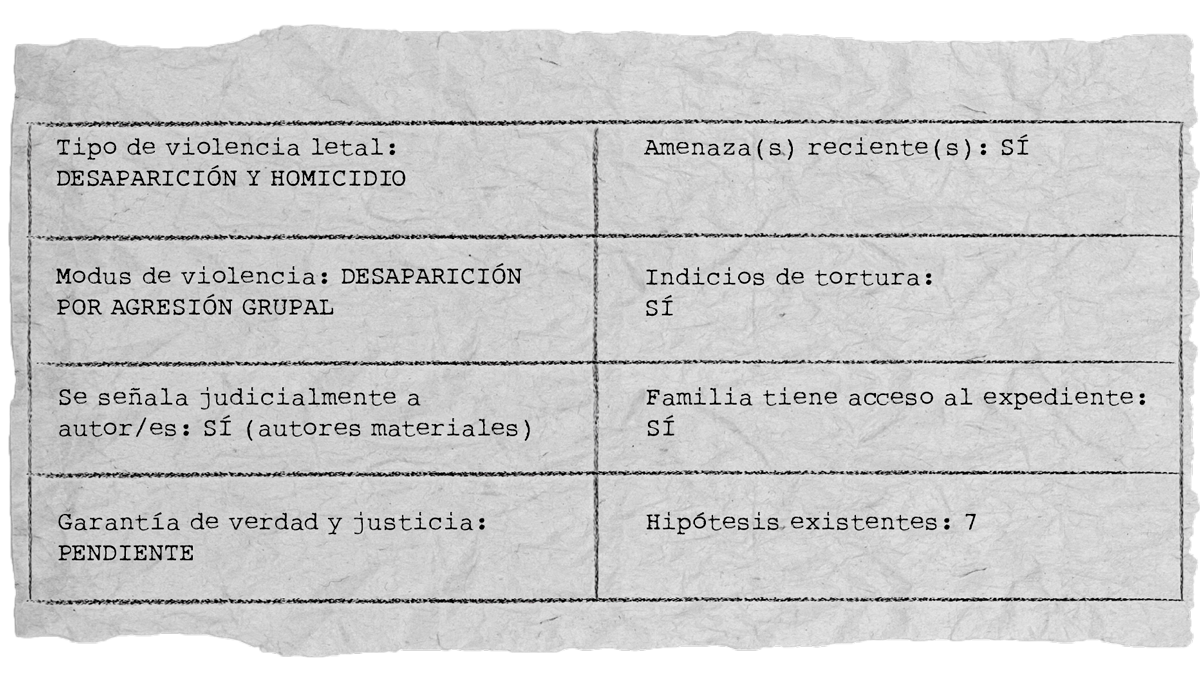
Facts
He disappeared on Monday, June 13, 2012. He was abducted at 11:30 p.m. as he was leaving the headquarters of Reporteros Policiacos. He was apprehended by 3 armed men without uniforms aboard a gray van. The Public Security Secretariat received a report of the kidnapping at 23:40.
His body was found the following day, mutilated and in black bags placed on Ursulo Galvan Street, near the newspapers Oye Veracruz and El Diario de Xalapa, a few meters from the Government Palace. On one side they left an orange poster board that read: “This happens to those who betray and want to be clever. Sincerely, Los Zetas»(1). As in other cases, there is a communicational staging, marked by the way and the place where the corpse was left.
The expert reports point out many signs of injuries and torture, and detail that the cause of death was “slow death of mechanical origin, directly related to compound wounds, of short blunt force type, causing the segmentation (amputation and decapitation of the body)”.
Threats
He had received multiple aggressions and threats over several years. Among the most recent, in 2012 he received telephone threats at the offices of Reporteros Policíacos. He denounced that they offered him protection and he refused to receive it, arguing that the protection was for people who were in bad situations, that he was not linked to criminals. He covered local security, police, general information and trials. He always had the police radio with him. His colleagues say that Victor Manuel kept a logbook with names and data of common criminals, recording dates of arrest, sentences and other data.
A fact to keep in mind is that a week before his disappearance, Governor Javier Duarte publicly gave him a car as a prize in a public event with journalists for the Freedom of Expression Day.
Investigation and prosecution
Authorities sought to link him to organized crime. The official hypothesis is that he was killed by two members of organized crime, people who died in a confrontation 5 days after Victor’s murder: Juan del Angel Torre and Daniel Reynoso Hernandez. It is unclear how the alleged perpetrators are identified.
Hypothesis
After the investigation and analysis of documentary and live sources, it was found that there are at least 7 hypotheses and/or motives: 1) The version in the file identifies two presumed perpetrators who die in an operation.
2) On the other hand, there was an attempt to link the journalist with criminal groups and activities, indicating that for this reason Los Zetas had allegedly claimed responsibility for the murder.
3) Another hypothesis shows that with his murder organized crime or some cartel intended to challenge the government and points out that the murder, the exhibition of his body and the poster were a message in a critical period where all these struggles and confrontations between criminal groups and authorities are taking place.
4) A colleague says that he was mistaken for someone else and that the message was for journalists loyal to Los Zetas, a sort of “either you keep quiet or we will kill you”.
5) Another colleague affirms that the murder was intended to intimidate and/or seek the closure of Reporteros Policiacos because the media outlet was proving irritating to some, mainly officials, as its publications were damaging the image of the government.
6) Some family members mention that Victor published a story about the stepson of the Secretary of Public Security, Arturo Bermudez Zurita, in which he mentioned that he used helicopters and official vehicles for personal use.
7) Finally, one of the strongest hypotheses: Milenio published a video in which members of the Navy were tortured by organized crime, this was not signed by Victor but everyone assumed that he provided the necessary information.
Case 11: Miguel Morales Estrada
Empirical journalist, 35 years old. Collaborated in Diario de Poza Rica and sold notes to other media such as Tribuna Papanteca and www.gobernantes.com
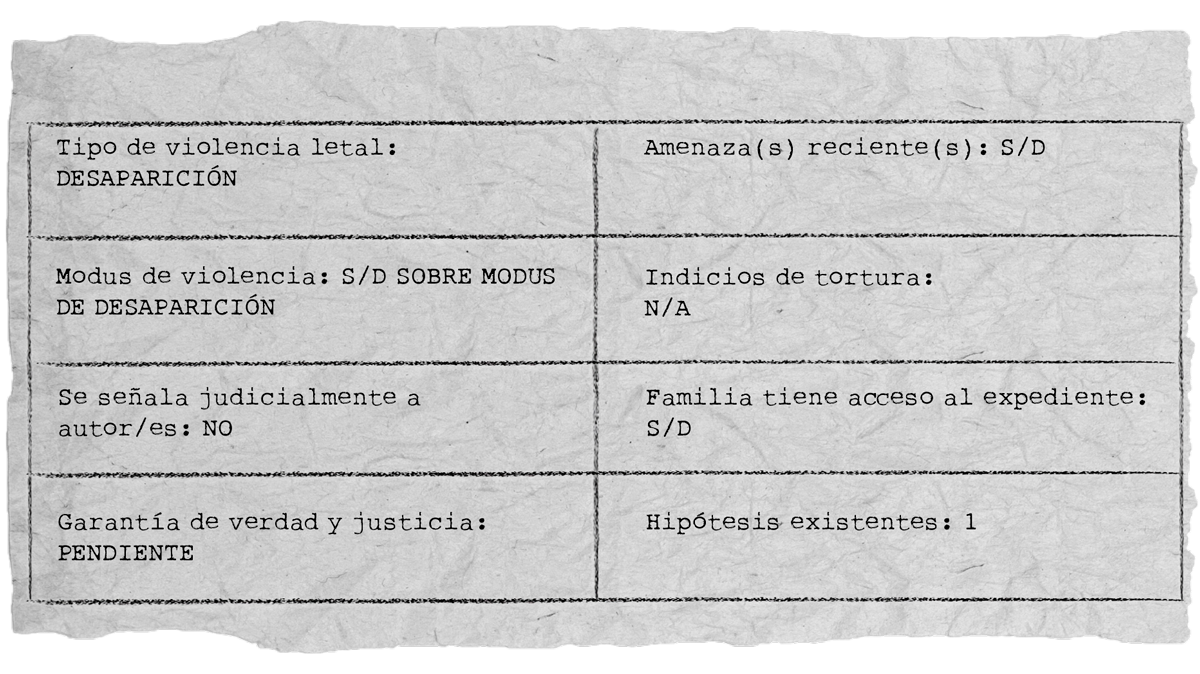
Facts
In previous days he had told the directors of Diario de Poza Rica that he needed to leave the city due to “personal problems”. On July 19 he went to the offices of the newspaper and entrusted his photographic equipment to the receptionist. That night he did not return home and has not been heard from since. On July 23 his wife reported him missing.
Threats
During interviews conducted by the press in the first days, his family said they did not know if he had received any threats, however, a live source said that he may have received threats but he was very private about his personal affairs.
Investigation and prosecution
Miguel Morales’ wife filed a complaint with the Veracruz State Attorney General’s Office. The PGJE initiated AP PZR/384/2012 but eleven years later there is no news on his whereabouts nor has any new information on the current status of the investigation been located in open sources.
In January 2015 UN-DH recalled that there are still pending disappearances that remain unresolved in Veracruz among them the case of Miguel Morales Estrada.
Hypothesis
The hypothesis is that his disappearance is related to the publication of a note that he signed and reported that a girl had drowned in a pool. The article was not published in the newspaper for which he worked -Diario de Poza Rica-, it was withdrawn during the night and did not appear in the printed version at the request of the girl’s relatives, presumably members of organized crime. However, they did publish the story with the journalist’s signature in another media outlet where he worked, Tribuna Papanteca. A live source believes that this is why they disappeared him, and points out that on July 19, Miguel went to one of those appointments – with organized crime or sectors linked to it – from which it is known that he rarely returns.
Case 12: Sergio Landa Rosado
Empirical journalist, 48 years old. He worked at Diario Cardel and collaborated with Reporterospoliciacos.com. He was also a public employee of the municipality of La Antigua.
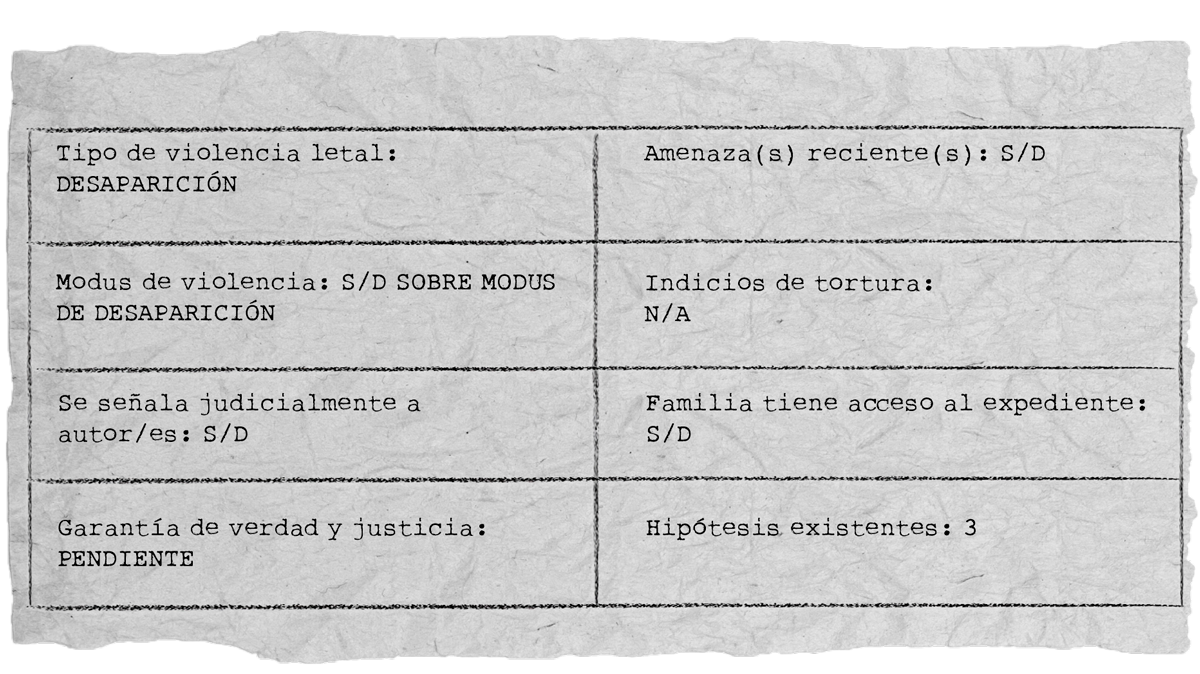
Facts
On Sunday, January 20, 2013, he received a call on his cell phone while he was working in the editorial office of Diario Cardel. He left without turning off the computer, telling a colleague that he would be back soon, not to turn off the computer, but he did not return.
His colleagues believed that his absence was due to sentimental conflicts and so it was not until the following day that they began to look for him. They said that when he was at the newsroom he received several calls and that he seemed worried. The newspaper reported his disappearance two days later and his wife filed a complaint with the authorities the following week.
Threats
In addition to working as a journalist he was a public employee in the City Hall of La Antigua, was a popular person in his community and in 2012 had accepted to be a candidate for local deputy for the Nueva Alianza party for Huatusco’s 13th district but a day before the elections he resigned his candidacy alleging that the party had not fulfilled its promises to finance the campaign and give an advertising agreement to Diario Cardel.
He had previously been kidnapped in November 2011, apparently following a publication about the murder of a cab driver. An armed group took him from the newspaper’s door. He managed to escape, it is unclear although some accounts indicate that he was rescued by the military and taken into custody in Xalapa, the state capital, after which he migrated to Acayucan and San Cristóbal de las Casas, Chiapas state. He had returned to Cardel a few weeks before his second disappearance. Colleagues report that the state police delegate, Marcos Conde, currently on trial for forced disappearance of persons, had summoned him to exchange information when the cab driver was executed.
Investigation and prosecution
To date, it has not been possible to locate data in open sources on the status of the investigation and the process. The situation was already denounced by the report on aggressions against journalists for the IACHR in its on-site visit to Veracruz -September 2015-. In it, when referring to the case of Sergio Landa, it states: “To talk about his case, to inquire about his possible captors, to know why (the facts happened), how his investigation process is going in the Attorney General’s Office of the State of Veracruz (PGJV), and to try to contact his relatives, is to run into a strong edifice of fear and silence…”.
Hypothesis
The consultation of documentary and live sources (interviews) have allowed us to conclude that there are at least 3 hypotheses about his disappearance:
1) That it happened because Sergio exposed himself to the police. In fact, he once covered a story about a state police officer who supposedly accidentally killed a detainee in Paso de Ovejas; from that moment on he began to be a target for the police.
2) Sergio was a staff reporter for Diario Cardel, which belongs to Grupo Editorial Olmeca. A media conglomerate that then had at least 10 newspapers and magazines. In that publishing group there was also another victim, another missing journalist: the young Gabriel Fonseca. Gabriel was 19 years old, of humble origin and also an empirical journalist. He worked at the subsidiary Diario de Acayucan. He has been missing since September 17, 2011, two months before the first disappearance of Sergio and four months before his disappearance. He was also taken away, it is not known what happened to him. It is presumed that the motive could be related to some problem between the aggressors and the editorial group.
3) His political participation as a candidate for deputy for the district of Huatusco, as he was a respected person in his community.
Case 13: Gregorio Jiménez de la Cruz
Empirical journalist, 42 years old. He was correspondent in Villa Allende of the Coatzacoalcos newspaper NotiSur, and also collaborated with the newspapers El Liberal del Sur and La Red. He also worked as a photographer of social events.
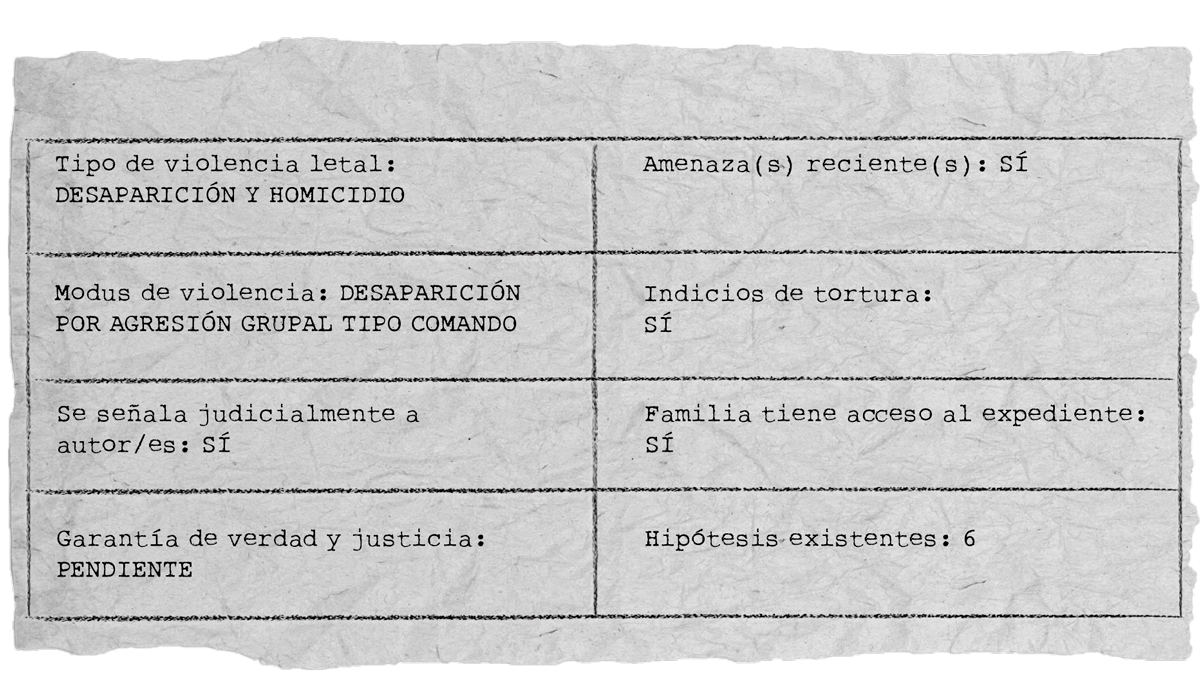
Facts
In the early morning of February 5, 2014, five armed men showed up at the door of his house, asked for him and when he came out they took him by force aboard a pickup truck. His family was present.
The government of Veracruz generated a search operation that included soldiers, marines and federal and state police. Gregorio was missing for 6 days.
On February 11 the government, through the State Attorney General’s Office, announced that his body had been found in a clandestine grave inside a safe house located in Las Choapas, a neighboring municipality to where he was kidnapped. In the same place was found the body of a person known as “El bembas” and the body of Ernesto Ruíz Guillén, who had disappeared a month before and whose case Gregorio had published about.
Threats
He had received threats as a result of journalistic articles, he had had security incidents related to his work and also because of a family conflict (allegedly, the son of Teresa Hernández -owner of the El Mamey establishment- assaulted Gregorio’s daughter). Subsequently, and before his murder, he received a death threat from Teresa Hermandez, as a result of a note that Gregorio published.
In 2018, the journalist’s widow denounced to the Prosecutor’s Office that they wanted to burn his house.
Investigation and prosecution
Gregorio’s wife, Carmela Hernández, in her statement to the authorities mentioned that he had been threatened by Teresa Hernández as a result of a publication he made about homicides committed in the bar he owned.
A colleague of Gregorio’s told the Public Prosecutor’s Office that Gregorio had also been in an argument with Mary Sam, owner of an important business in the city of Coatzacoalcos, the luxurious restaurant Piquitos.
In the case, José Luis Márquez Hernández was arrested and confessed to being Gregorio’s killer. He said that he did it at the request of Teresa Hernández, in collaboration with El Mani, la Yegua, Choky and Babidi and that they had hired them as hitmen for 20,000 Mexican pesos.
He detailed that after kidnapping the journalist, they took him to a house that they usually use for these acts (known as “safe house”) and they kept him there until 3:00 a.m. on February 6, the day when they set in motion a preconceived plan: to murder the journalist. According to the account of the alleged confessed murderer: they left the house, guided him to an open field, and there they carried out the lethal acts of aggression.
In the case Teresa de Jesús Hernández Cruz, owner of the bar called El Mamey, was also arrested, who would be the mastermind, as well as other alleged perpetrators: Juan Manuel Rodríguez Hernández, Santos González Santiago, Jesús Antonio Pérez Herrera. Gerardo Contreras Hernández, Servando Montalvo, and the aforementioned Márquez Hernández.
Hypothesis
Gregorio published about disappearances and kidnappings in Villa Allende. He was the one talking about these issues in the Coatzacoalcos area. This was bothering the criminal group operating in those businesses, which were allegedly linked to bars, restaurants and others.
Months before, he had published articles about the El Palmar bar (owned by Teresa Hernandez) and about the kidnapping of Ernesto Ruiz Guillen, which occurred on January 18, 2014. According to a live source (interview) one of Gregorio’s sons-in-law was Teresa Hernandez’s son; apparently the latter mistreated one of Gregorio’s daughters and for that reason there was a conflict between the in-laws. Gregorio tried to dialogue with Mrs. Hernandez and with the help of an agent of the Public Prosecutor’s Office whom he knew, they reached a “non-aggression” agreement.
According to the daughters, Gregorio published a note about two people stabbed outside the cantina El Mamey -also owned by Teresa Hernandez-. After the note, she threatened to kill him, saying that she knew people from the Zetas cartel and that she would have him killed.
On the other hand, it is also mentioned that Gregorio had had an affair with Mary Sam, a powerful woman in Coatzacoalcos and owner of the restaurant “Piquitos”. This information, according to the source, was brought to the Public Prosecutor’s Office during the investigation but was not taken into account by the authorities.
Gregorio wrote a note about a property owned by Mary Sam, a ranch or quinta in Villa Allende, stating that kidnappers were operating there and were holding people hostage. The event took place on September 27, 2013, 3 kidnapped people were rescued from the property and two alleged suspects were arrested: Marco Antonio Fermín Vázquez and Wenceslao Altamirano San Juan. The news was reported in several media but without many details, while Gregorio mentioned to whom the property belonged. Live sources indicate that Mary Sam is a person with influential networks and links, politicians and businessmen, and that she not only has businesses but also runs an NGO that supports people in prison or who have already served their sentences.
In summary, there are several possible motives and hypotheses about Gregorio’s murder, all of them related to his journalistic activity: notes related to the phenomenon of disappearances, or by a group of organized crime that was linked to certain bars-restaurants, or by the relationship of these and private individuals with the kidnapping of migrants. However, the authorities dismissed that his death had to do with the exercise and risk of his profession as a communicator. On the contrary, the official narrative affirms that the journalist’s murder was the result of a personal “vendetta” between him and Teresa Hernández.
Case 14: Moisés Sánchez Cerezo
Empirical journalist. Founded the newspaper La Unión, a newspaper critical of the municipal governments of Medellín, a municipality near the port of Veracruz.
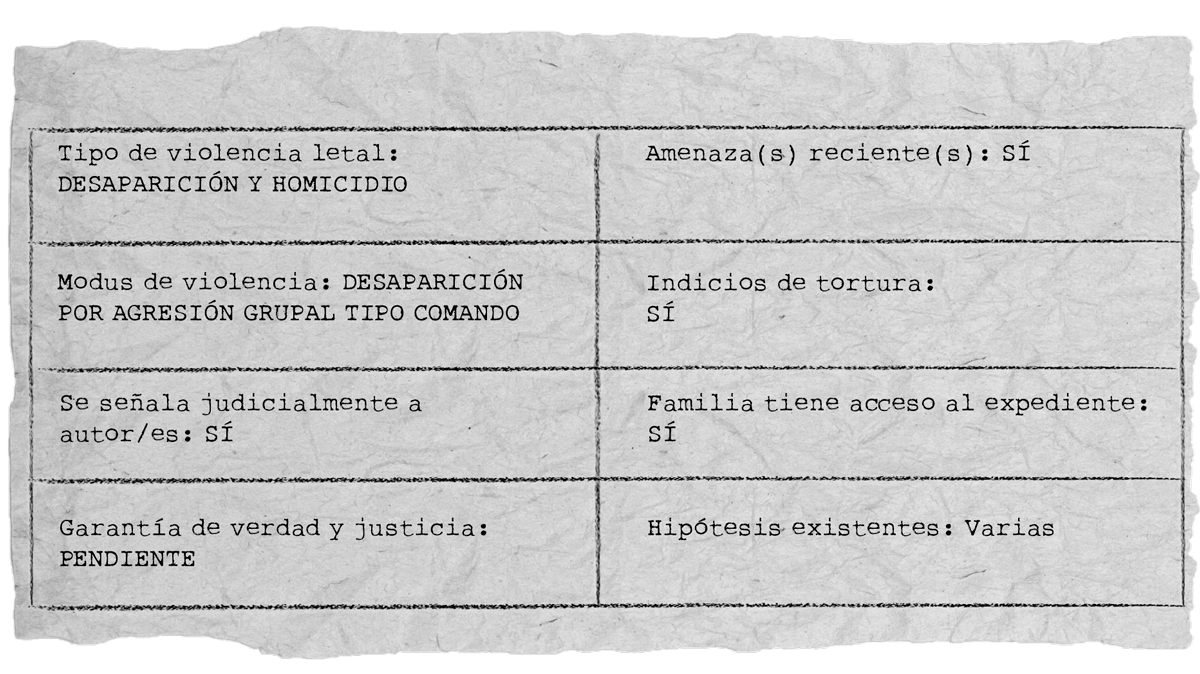
Facts
On Friday, January 2, 2015, a group of approximately nine men with long guns and their faces covered broke into the Sánchez family’s home. They were looking for Moisés. Without putting up any resistance, Moisés came out and they put him in a vehicle. They rifled through his belongings. They took his computer, his Nikon D40 camera, a tablet and his cell phone. According to press reports, investigations revealed that although he was kidnapped by hitmen from the Jalisco Cartel – New Generation, they were supported by state police and municipal transit agents.
The then governor of Veracruz, Javier Duarte, said that Moisés was not a journalist but a “cab driver” and “activist”, publicly dismissing the case.
On January 24, after 18 days missing, his remains were found in the neighboring municipality of Manlio Fabio Altamirano after the confession of ex-cop Clemente Noé Rodríguez, who said he had murdered the journalist the same night of the kidnapping. Moisés was dismembered and his body was placed in black plastic bags.
Threats
He had been intimidated on several occasions. He was threatened at gunpoint during the mayoralty of Aquiles A. Rodríguez Exsome (1998-2000); with another mayor, Omar Cruz Reyes (2013-2015), he had public friction. Moisés participated in various protests, led some, and was a candidate for municipal agent. As a journalist he published the creation of a self-defense group in Medellín, which evidenced the deteriorating security conditions and is the situation that many colleagues identify as the moment that could have culminated in his murder. At the end of December he told his wife that he had been told that Mayor Cruz Reyes was planning to “give him a scare”. A few days passed before an armed commando took Moises away.
On Monday, January 5, the mayor was questioned about the kidnapping of Moises Sanchez and responded: “He who owes nothing, fears nothing. On Wednesday, January 7, he no longer showed up for work, abandoned his post and fled.
Investigation and prosecution
In a press conference, the then prosecutor of Veracruz, Luis Ángel Bravo Contreras, affirmed that the mayor of Medellín, Omar Cruz Reyes, was the guilty party in the murder of Moisés Sánchez. In the investigation he is identified as the mastermind. He continues to be a fugitive from justice.
Former intermunicipal police officer Clemente Noe Rodríguez was arrested at the time. In a statement issued shortly thereafter, the Attorney General’s Office indicated that the detainee said that “five other people” participated in the kidnapping and murder, and that the act was committed “by direct order of Martin Lopez Meneses (Martin N), deputy director of the municipal police of Medellin” and bodyguard of the then mayor. Subsequently, official experts of that institution determined that the defendant was subjected to acts of torture. Martín “N” was arrested but was released in November 2015 after irregularities were found in the indictment.
Former police officers Luigi Heriberto Bonilla Zavaleta and José Francisco García Rodríguez, both motorcycle patrolmen, were arrested. They were accused of not acting when the journalist’s family asked them for help after an armed commando kidnapped him.
On March 27, 2018, the former police officers identified as Luigi Heriberto “N” and José Francisco “N”, who were prosecuted for the commission of the crimes of aggravated intentional homicide and failure to comply with a legal duty, were sentenced on March 27, 2018. They were sentenced to 25 years in prison plus reparation of damages (criminal case 100/2017). Then the sentence was appealed, modified to only six and a half years, only for the crime of non-compliance. In 2021 the two policemen regained their freedom. After this, Jorge Sánchez, Moisés’ son, also appealed, which caused the sentence to be modified for the third time, ordering that they be prosecuted for intentional homicide. The defendants were already free; Luigi Heriberto Bonilla Zavaleta was re-arrested on Thursday, March 30, 2023, but the following day he was released again. On August 18, the First Collegiate Court in criminal matters in Veracruz granted the latter’s plea by determining that there was insufficient evidence to prove the crimes of breach of duty and homicide and the responsibility of Luigi N, against journalist Moisés Sánchez.
Hypothesis
There are elements about the motives and all of them are related to the risks involved in his journalistic work. He covered controversial issues such as unfinished works, questioned local authorities and publicly confronted the municipal president.
The first person pointed out as possibly responsible was the municipal president of Medellín, Omar Cruz Reyes, who had said he was going to do something to him because of the video Moisés published about new self-defense groups.
Sources interviewed said that part of the municipal police force was involved with organized crime. They say that Meneses, in charge of the municipal president’s security, was implicated and point out that on the day of the kidnapping there were around 11 police officers near the Sanchez family’s home who did not respond to the call for help (for which they were later arrested). According to this hypothesis, Meneses would then be the intermediary between the municipal president and the perpetrators of the kidnapping and murder of the journalist.
The ministerial investigation revealed that those who kidnapped him were hired killers from the Jalisco Cartel – New Generation with the help of state police and municipal transit agents.
Finally, there is a hypothesis that the prosecutor blamed the mayor for a confrontation he had with the mayor, but that in reality the act was carried out by an organized crime group with which the prosecutor had ties.
Case 15: Armando Saldaña Morales
Reporter, journalist, 52 years old. He collaborated with several media in the area of Córdoba and Tierra Blanca: El Mundo de Córdoba, El Sol de Córdoba, La Crónica de Tierra Blanca, Radio Max and La Ké Buena.
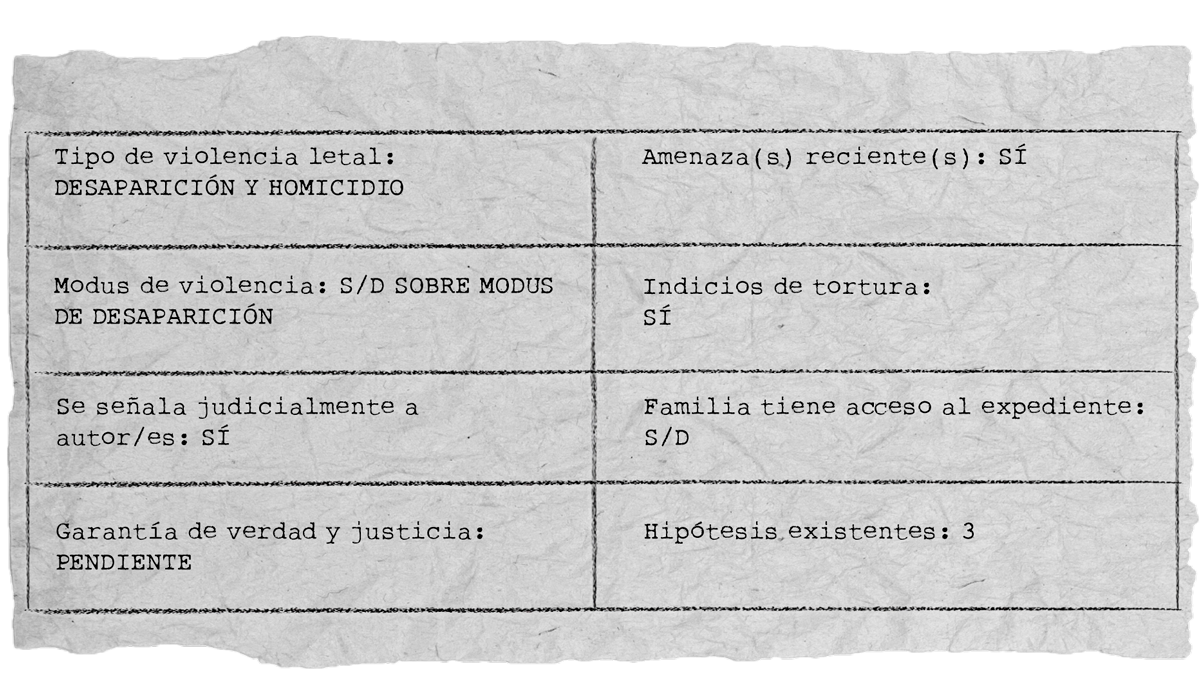
Facts
He was last seen on Sunday, May 3, 2015 in Tierra Blanca. Some sources quoted by the press indicate that he was intercepted on his way to his home in the community of Laguna Chica, in the municipality of Tezonapa, Veracruz; others indicate that he went to a party on Saturday night, where he was allegedly abducted by armed men.
The following day, on Monday, May 4, his body was found on the banks of a stream between the communities of Morelos and Rancho Tablas, in the municipality of Cosolapa, Oaxaca, 10 km from where he lived. He had 4 shots and traces of torture, he had his IDs and radio credentials with him.
Threats
On Friday, May 22, the State Investigation Agency (AEI) of the state of Oaxaca arrested Juan Carlos de la Cruz Vergara, 25 years old, in the municipality of Acatlán, who was allegedly responsible for the crime of aggravated homicide with aggravating circumstance of advantage, to the detriment of Armando Saldaña. This in compliance with the arrest warrant of the case 147/2015 released by the Judge of Guarantees of San José Cosolapa.
Hypothesis
The authorities did not make public the hypothesis that led to the arrest of Cruz Vergara. Beyond that, there are at least two other explanations about the possible motive for his murder. Both are linked to his journalistic work:
1) He was killed because he touched particular interests in the area where the kidnapping of migrants and fuel theft grew in criminal incidence. “He did not bite his tongue. If he spoke about sugar cane growers, he said what he thought, even though this is one of the most sensitive issues in the Tierra Blanca area because there are big money and power interests”, said a colleague to the press.
2) Days before his disappearance he made known the existence and details of the operation of criminal huachicoleros, that is, those who stole fuel from PEMEX in the area where he lived. This hypothesis suggests that Armando Saldaña reported the actions of these gangs, whose modus operandi to silence denunciations was extreme violence, torture and summary execution. A similar situation was experienced by journalist Octavio Rojas Hernández, correspondent of the newspaper El Buen Tono de Córdoba, who was murdered on August 11, 2014 and who also reported on the presence of the “chupaductos” in the area. As in the case of Armando Saldaña, the body of Octavio Rojas was found – or deposited perhaps – a few kilometers away but on the side of the state of Oaxaca.
For more details on the case and reference sources, see “Violencia letal contra periodistas. Caso Veracruz 2010-2016.”
Case 16: Juan Atalo Mendoza Delgado
Empirical reporter, age 46. For 15 years he was an employee of El Dictamen and occasionally collaborated in Notiver. After resigning from El Dictamen he founded his own digital media called “Escribiendo la verdad. Authentic tribune of Veracruz”. He also worked as a cab driver, had his own car and had joined the PRD. He was making efforts because he wanted to compete in the next elections for mayor of Medellín.
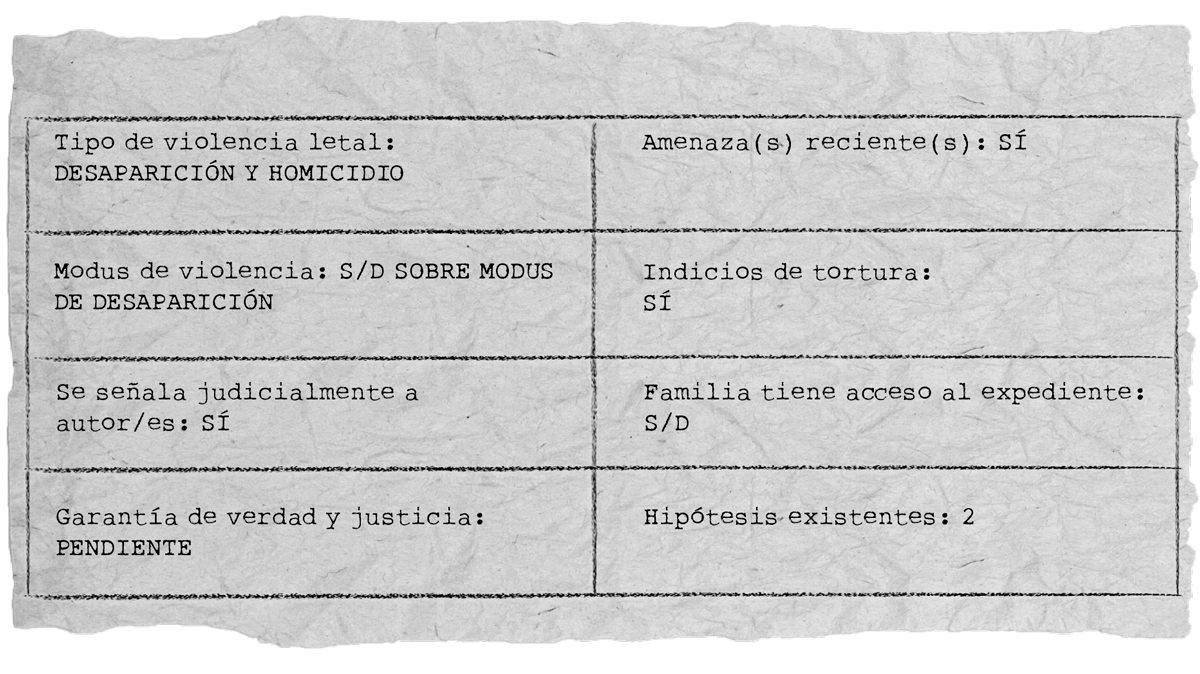
Facts
He was reported missing on June 30, 2015. That day he left to work in his cab and was last seen in the community El Tejar, municipality of Medellín, where he resided.
His body was later found in the middle of the road. The expert examination established that he had multiple injuries from being run over, so the Veracruz Attorney General’s Office said that his death was not related to his journalistic work, and even insisted that his death was accidental. However, his body was found half-naked, tortured and with a blindfold over his eyes.
His car – Nissan Tiida with cab paint and economic number 1962 – was not found at the scene, nor was his camera or notebook.
Threats
Juan Mendoza covered police information, known as nota roja. Despite this, and as far as family members and authorities have reported, he had not received any intimidation or threats.
Interviewees indicated that a few days before his death he had a problem with some people who wanted to rob his cab; he denounced them but later they went free.
Hypothesis
Juan Mendoza worked at the newspaper El Dictamen for many years and then opened the web portal Escribiendo la Verdad. He had a column called “¿Por qué callar?” in which he warned about the presence of crime and denounced local politicians who were said to be linked to the Los Zetas cartel.
The lethal aggression against the journalist took place in Medellín, a municipality where three months earlier -on January 2, 2015- Moisés Sánchez Cerezo, also a journalist, was kidnapped and murdered (case 11). The former mayor of that place, Omar Cruz Reyes, was identified as the mastermind of Moisés’ death and to date he is a fugitive from justice. The information is relevant because some interviewees point out that Juan Mendoza was about to run for mayor and that this was not well received by those who occupied public administration positions.
The official hypothesis is based on the hit-and-run accident. However, photos of the scene of the discovery were made public and they show that the semi-naked body was left on the road with the head/eyes bandaged with a gauze through which a blood stain appears, as if filtered. This could indicate that before his death, the journalist was injured and treated by someone.
Case 17: Rubén Espinosa Becerril
Self-taught photojournalist, 31 years old. He collaborated with Agencia Eklipse Photo, El Golfo Info, Agencia AVC, Cuartoscuro and Proceso. He was one of the founders of the Voz Alterna collective. He also worked as a photographer for the campaign of the later governor Javier Duarte and for the mayor of Xalapa, Elizabeth Morales, in the area of social communication.
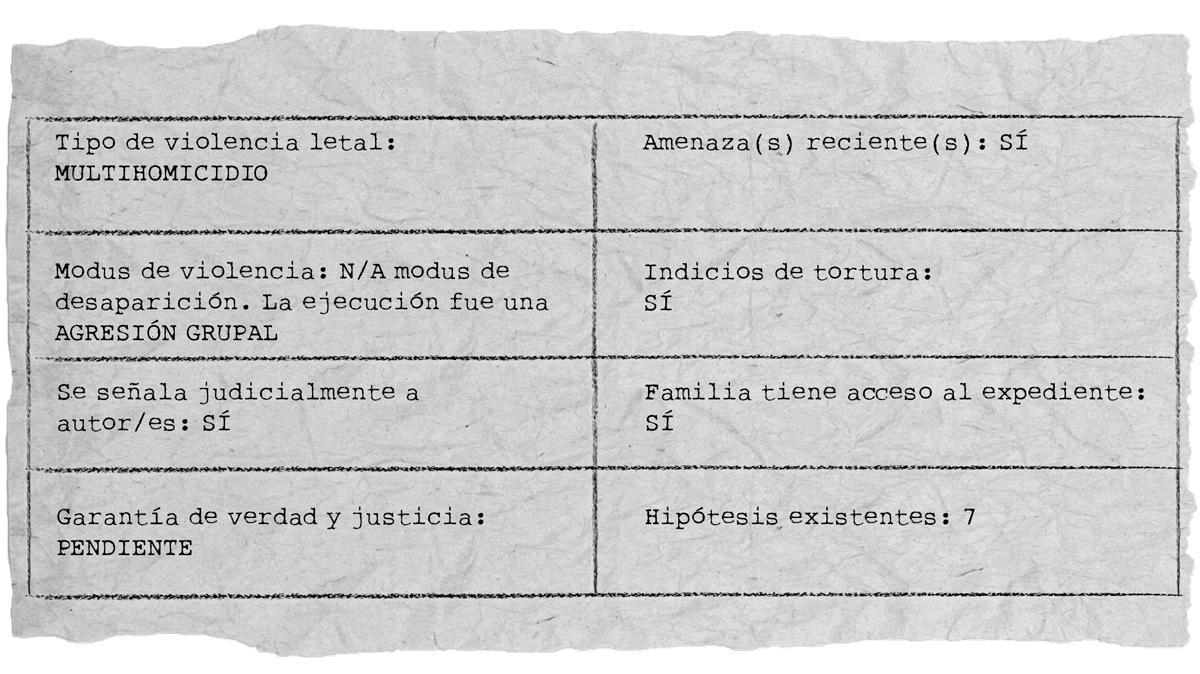
Facts
He was murdered in Mexico City on July 31, 2015 along with 4 other victims: Nadia Dominique Vera Pérez -activist and friend of Rubén-, Mile Virginia Martín, Yesenia Atziri Quiroz Alfaro and Olivia Alejandra Negrete Avilés. The first three lived in the apartment located at 1909 Luz Saviñón Street, in the Narvarte neighborhood, where the murders took place. Negrete Avilés worked as a housekeeper in the building.
The crime was discovered around 7:00 p.m. the same day by the fourth inhabitant of the apartment.
The bodies of Rubén Espinosa and Nadia Vera were found on the floor of one of the bedrooms, covered by sheets. Mile and Yesenia were in another room: the former’s body was on the bed and the latter’s body was lying on the bathroom door integrated to the bedroom.
According to the report of the Gender Crimes Context Analysis Unit of the Mexico City Attorney General’s Office, Ruben was the first to be subdued; he was tied by the upper and lower extremities with gray tape. He had 12 stab wounds. The cause of death was a firearm projectile impact. Nadia was tied up, asphyxiated, and suffered stab wounds.
Yesenia and Mile had objects in their oral cavity to limit their speech. The former was tied up, asphyxiated and wounded with the same sharp instrument as the others. Mile suffered the same attacks but her body was the only one found half naked and with clear signs of sexual violence.
Alejandra’s body was found in the bathroom. She had no sharp wounds, she was not asphyxiated nor did she present injuries from restraints (bindings). She died from a gunshot wound, as did the other 4 victims.
Threats and incidents
Ruben was a well-known person in the public environment of Xalapa, capital of Veracruz. He was a photographer for Javier Duarte’s gubernatorial campaign and worked for Mayor Elizabeth Morales until 2013.
As a photojournalist he covered mainly social movements. He participated in demonstrations and protests to denounce murders of fellow journalists as well as harassment of students critical of the government. Through his photographs he documented abuses of power by the government headed by Javier Duarte. In 2013, Ruben Espinosa filed a complaint before the PGR for the operation carried out by SSP in Plaza Lerdo on September 14, 2013 (132/FEADLE/2013), in which he and other journalists were violated by authorities. Also during the photographic coverage of June 8, 2015 in Xalapa he was verbally and physically assaulted.
He moved to the capital of the country after receiving threats, among which he reported having been beaten, followed and watched on several occasions. According to accounts he gave to various media, on Wednesday morning, June 10, 2015, he noticed a person outside his home in Xalapa. In the afternoon, two more individuals remained in front of his home. “Three of them were looking at me in an aggressive manner, there was the first guy, who apparently took a picture of me and made a sign to me like ‘What the f***?’”. At night, when he was returning home, two people followed him so he took refuge in a baby store. Minutes later the photojournalist continued on his way. Before arriving he noticed that outside his house two other people were waiting for him. When they saw him they walked towards him and Espinosa stepped aside to let them pass. They stopped, stared at him and left. The day before, he had led the ceremony for the unveiling of a plaque in honor of journalist Regina Martínez, murdered in the same city on April 28, 2012. He said that in recent years he had been denied access to cover local government events.
In a meeting he held with Jorge Sánchez, son of murdered journalist Moisés Sánchez, and Pedro Canché, a journalist persecuted for his work, Rubén told them: “It is perfectly clear to me that it is the governor of Veracruz, Javier Duarte, who is persecuting me. He is not a local cacique, he is a fan of the dictator Franco. That is why I fear for my life. That’s why I’m running away from Veracruz, I don’t want to be number 13, besides it’s bad luck”. This is how Canché told it some time later.
Investigation and process
The Attorney General of Mexico City, Rodolfo Ríos Garza, said in a press conference that several lines of investigation were opened, among them that of an alleged robbery. He also said that the protocols for femicide, homicide and crimes against journalists were activated. He did not refer to the denunciations of threats from Veracruz made by Rubén Espinosa and Nadia Vera.
Article 19, after accessing the investigation file, found multiple irregularities.Among them was that there were at least five and not three people who participated in the crime.However, the investigations continue to stall.
His relatives have requested the PGR, now FGJCDMX, to exhaust the lines of investigation related to Ruben’s work activity, they also stated that the recommendation made by the State Human Rights Commission of Mexico City (04/217) has not been complied with. More than 8 years after the multihomicide and in spite of the claims, those in charge of the justice system have not achieved substantive advances in the case.
Hipótesis
There are several hypotheses, some linked to Ruben’s work as a journalist and Nadia as an activist. At the moment, there are 3 lines of investigation in force: 1) The possible link between the fact (multi-feminicide and homicide in the Narvarte neighborhood) with Nadia Vera’s activism and Ruben Espinosa’s photojournalism activity in the State of Veracruz during the administration of Javier Duarte as Governor and his enforcement arm Arturo Bermudez Zurita as Secretary of Public Security; 2) the possible link between the event and people who could have victimized Mile Martin and Yesenia Quiroz in human trafficking activities and; 3) the possible link between the event and Organized Crime. None of these lines have been exhausted.
Based on the statement of the three detainees, the PGJDF is feeding the line of investigation related to the alleged drug dealing and human trafficking as motives. According to the PGJDF investigation, one of the victims allowed access to the building and the apartment to three individuals, identified as Daniel Pacheco Martínez, Abraham Torres Tranquilino and César Omar Martínez Zendejas, who are currently in prison and have been sentenced.
The same version indicates that, in approximately 50 minutes, the assailants entered the place where they beat, subdued, tortured and killed the victims. In addition, according to the version of the Attorney General’s Office, the assailants searched the place looking for something. When they left, they were recorded by video cameras, which showed that one of them was carrying a black suitcase and that another one took the Mustang car parked outside the building, property of Mile Martin. This was, for years, the official version.
The investigation was plagued with irregularities and the rights of the victims were violated, which gave rise to recommendation 4/2017 of the CDHDF.
Case 18: Anabel Flores Salazar
Journalist, 36 years old. Has collaborated with: Diario El Mundo, El Buen Tono and El Sol de Orizaba.
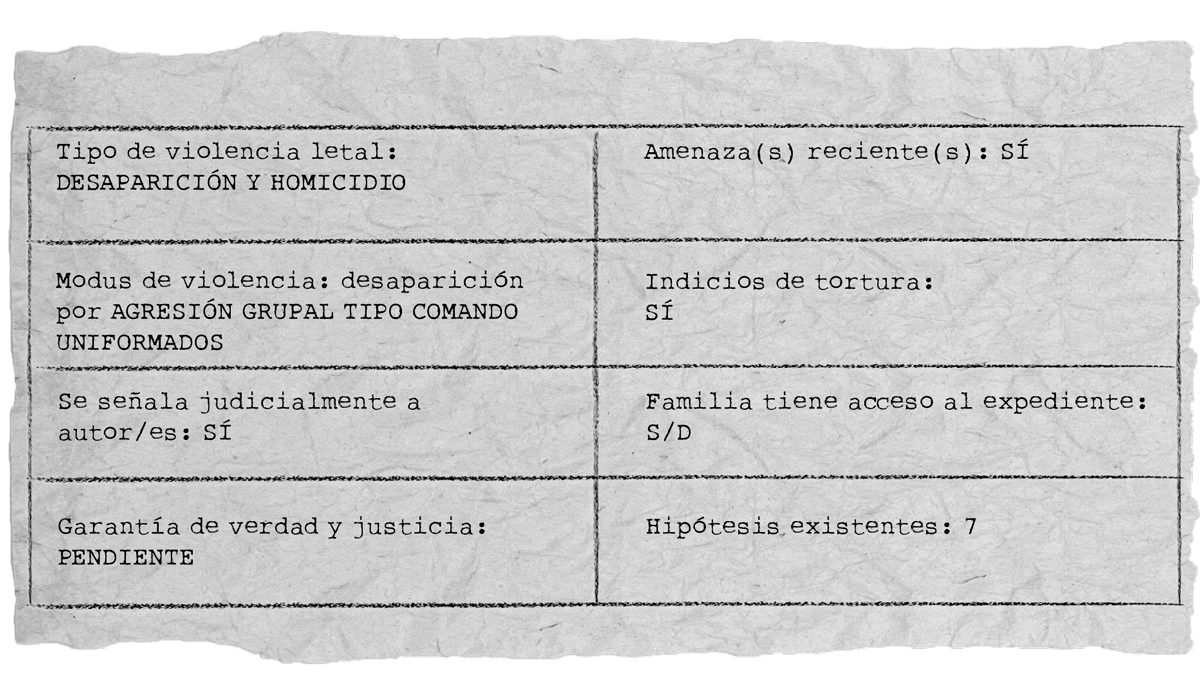
Facts
She was kidnapped in the early morning of February 8, 2016 by a group of men in uniform “like military men” who arrived at her home and dragged her away, according to what her relatives reported at the time. The men pointed guns at those who tried to stop the kidnapping. They ordered everyone to get down on the ground and said “we have an arrest warrant”. Witnesses saw three gray Nissan pickup trucks. They also said that the assailants were wearing a soldier’s uniform, a black vest, black boots, a helmet, a balaclava and a bulletproof vest. They say that the assailants spoke little among themselves and only uttered phrases such as “not here” (when they were in the wrong room), “this is it” (when they found the journalist), “we have an arrest warrant” and “get down on the floor”.
Anabel’s body was found the next day, February 9, 2016, on the Cuacnopalan-Oaxaca highway. She was half-naked, handcuffed and her head covered with a plastic bag; she had traces of torture.
Threats
She had had a security incident on August 30, 2014 while celebrating her birthday, accompanied by her family-including children-at a restaurant in the municipality of Acultzingo. Then a commando of soldiers arrived and began to search them. Anabel said “I am a journalist, why are you doing this? In response, one of the soldiers answered “look, you are eating with the enemy”, referring to someone else who was in the same restaurant. The journalist documented with her cell phone what was happening. The soldiers erased the photographs she had taken and told her to leave so that she would not get into trouble, according to a witness.
Investigation and Prosecution
The prosecutor said that “all probable links” would be investigated, including organized crime. He later said that the journalist was killed because of articles she published that “affected the interests of a criminal group”.
In August 2016, two individuals were arrested: Gonzalo Paulo Vélez (Gonzalo Paulo N), as the alleged perpetrator, and Manuel Escalona Barradas (Manuel N), alias El Cachorro, identified as the head of Los Zetas in Córdoba and Orizaba, the alleged mastermind. Governor Duarte publicly congratulated the authorities for the capture.
Prior to Anabel’s murder (February 2, 2016) José Márquez Balderas, alias El Chichi had been arrested in a vehicle control and inspection operation. By virtue of the lines of investigation he was identified as the alleged mastermind, but was later released for violations of due process.
Hypothesis
Two hypotheses were used. In a generic way, the prosecuting authority indicated in the media and open sources that the case could be explained by alleged links with organized crime. Other people linked Anabel’s murder to a publication she had made on Facebook about who was going to be the successor of the alleged head of the Los Zetas cartel in the region, José Márquez Balderas, alias El Chichi, who had recently been captured; the publication mentioned that El Chichi was going to be replaced by El Cachorro, son of the Director of the Ciudad Mendoza police.
On his Twitter account, on February 13, 2016 -five days after the journalist’s kidnapping-, Governor Javier Duarte remarked the second hypothesis. He commented that Anabel Flores had published under the pseudonym of Mariana Contreras the arrest of the plaza chief – el Chichi -. He replicated the original publication by Flores herself on her account (see photo).
Four months later Manuel N., alias “El cachorro,” was arrested. He was also being investigated for extortion, selling protection to mayors in Veracruz and other illicit activities.
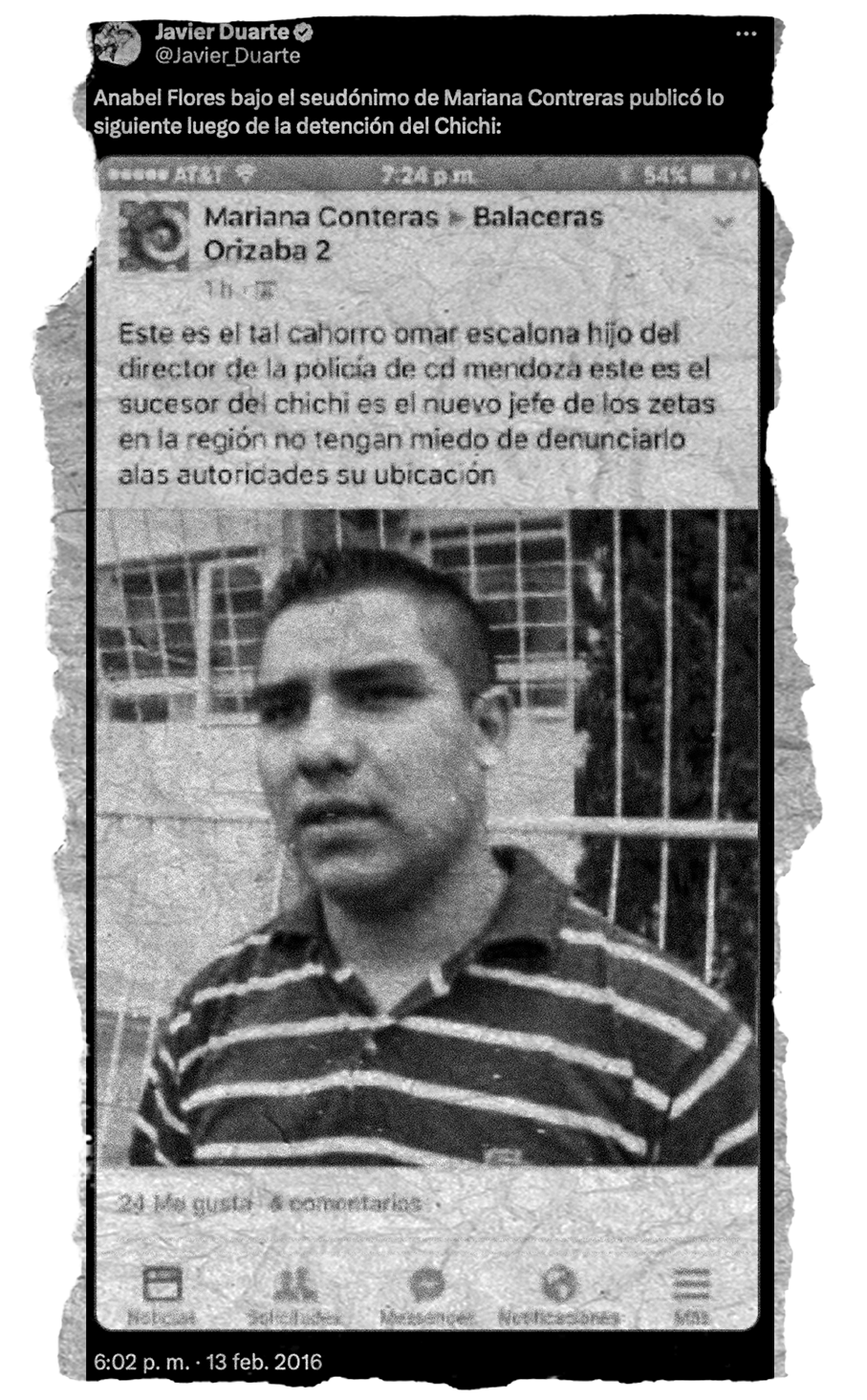
Case 19: Manuel Torres González
Reporter, 45 years old. He collaborated with: TV Azteca, Noreste de Poza Rica, Imagen del Golfo, Papantla Tukulama, Diario de Poza Rica and El Mundo de Poza Rica. He was director of a news media owned by him: Noticias MT. He also worked at the Poza Rica City Hall.
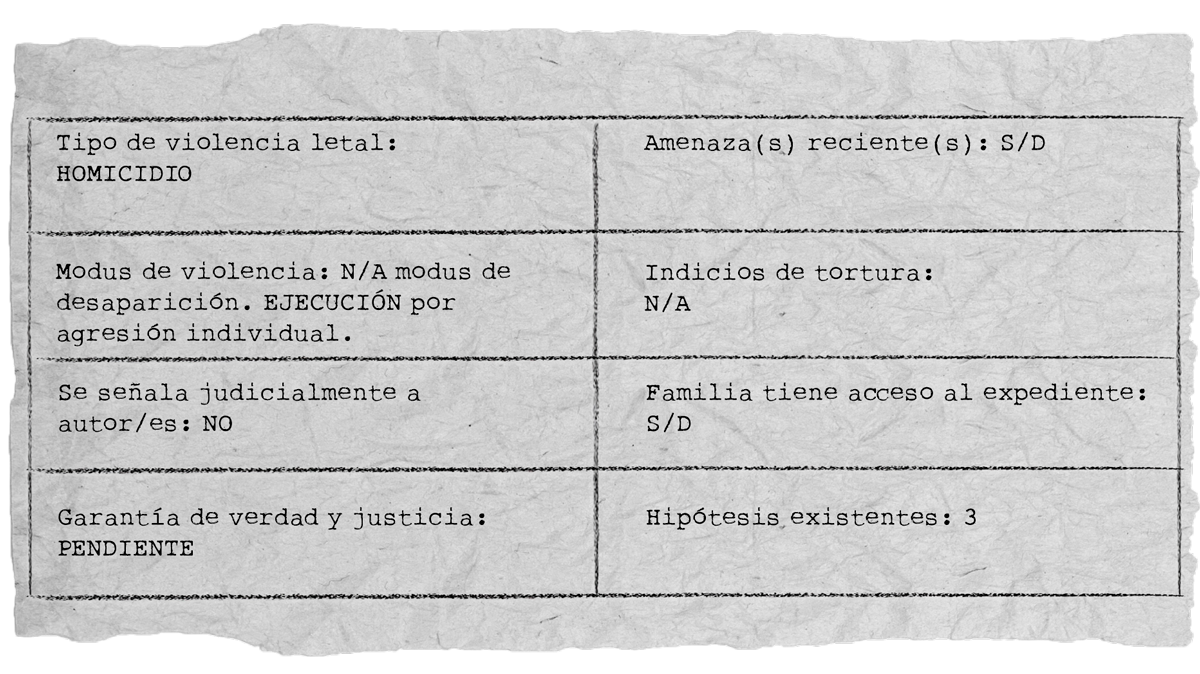
Facts
On May 15, 2016 he was murdered while walking through a well-to-do and crowded commercial area of Poza Rica. According to media reports, that Saturday morning Manuel Torres was covering an event of the National Chamber of the Transformation Industry -CANACINTRA- and from there he went to another event of the Green Ecologist Party of Mexico -PVEM-, where the councilman Carlos Christfield was. The latter offered him a ride to 2 de abril street, near the offices of the Transit Authority. There, the journalist got out of the vehicle, walked a few meters until a man approached him and shot him in the head with an accurate shot that ended his life immediately. His body was left lying on the asphalt.
Threats
His last publications were aimed at highlighting protests by workers of Petróleos Mexicanos (Pemex), the lack of water in some areas of Poza Rica and conflicts between criminal groups and security forces. However, as far as his professional career is concerned, his great informative vein was judicial or police reports, although he was careful to avoid details or information about organized crime, according to his colleagues. He preferred to report on other topics, as well as criticize politicians and officials, said a colleague in an interview with the press in the days following the murder.
In mid-2015 he founded his media outlet – MT – where he did not report on police or organized crime, but rather on government activities, the public safety secretariat and political campaigns in the region.
In addition to being a journalist, Manuel Torres was a collaborator with the Poza Rica city council, working as an assistant to Juan Carlos Ortiz Christfield, a Poza Rica city councilor, whom he sporadically accompanied when there was no news to report.
According to CEAAP, he had not reported any threats.
Investigation and Prosecution
Torres had been a journalist for more than 20 years. He was a correspondent for TV Azteca, Radiover.com and collaborated with several local media such as Diario Noreste. However, in reporting the murder, the statement from the Veracruz State Attorney General’s Office identified Manuel as a “collaborator of the city council” and not as a journalist. The regional prosecutor for the northern zone of Veracruz, Ezequiel Castañeda, remarked in an interview that there was no indication that the death was related to freedom of expression.
CNDH took over the case since May 16, 2016.
No progress in the investigation or the process has been made public.
Hypothesis
1) Official statements detailed that there was no evidence to affirm that the death was due to his work.
2) As in other cases, open sources -media, colleagues and others- pointed out that the lethal attack was a consequence of the risk of practicing journalism in certain contexts such as Veracruz at that time.
3) One source interviewed pointed out that Manuel had once been in contact with a national security force and that this probably gave him access to certain information that ended up putting him in danger.
Case 20: Pedro Tamayo Rosas
Empirical reporter, 43 years old. Contributor to: El Piñero de la Cuenca, Al calor Político, Mi Revista Veracruz and El Cañero de la Cuenca. He founded his own news portal, En la línea de fuego. He also worked as a government employee in the Planning and Strategy area of the Veracruz Public Security Secretariat.
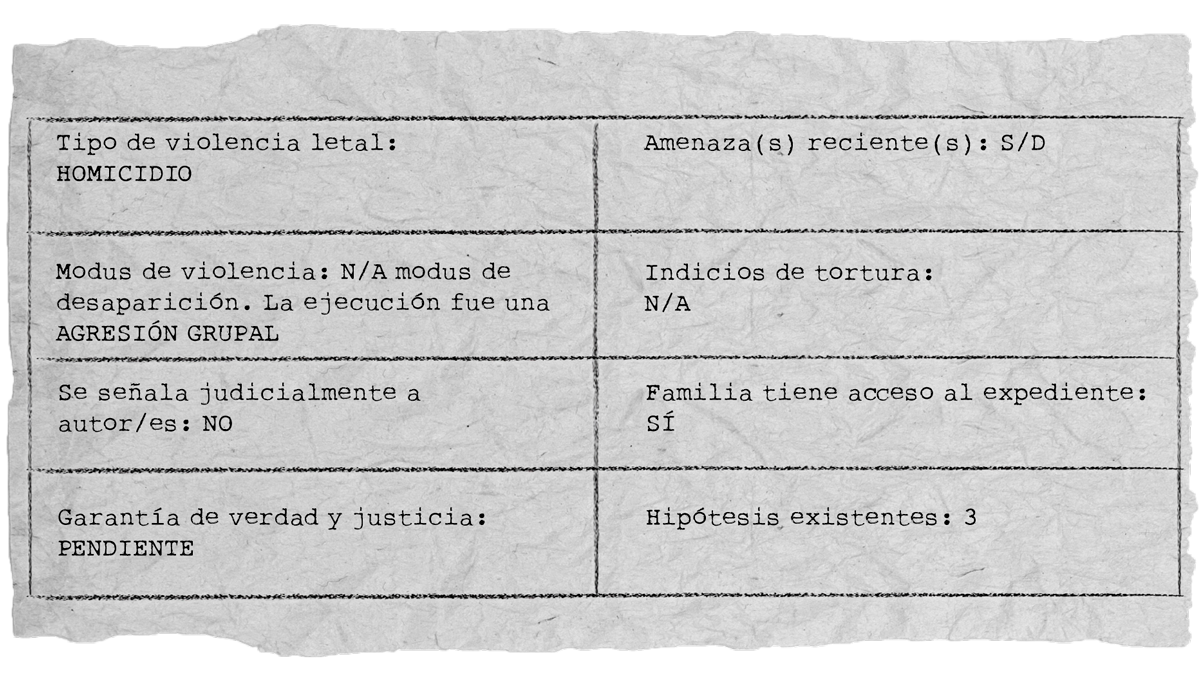
Facts
On Wednesday, July 20, 2016, after 10 p.m., two men opened fire on him while he was attending with his wife and children a family food stand outside his house called “La jardinera”. Specialized FGJE experts collected several percussion casings, 9 mm caliber.
Testimony from a family member indicates that before the execution, “a patrol car crossed the avenue, impeding the passage of other vehicles and facilitating the access of the compact car used by the assailants who came to attack Pedro”. The individuals who fired the shots left “calmly, they did not run, they did not seem to be in a hurry, nor alarmed, they took their car” and, after an exchange of high beams with the patrol car, “they left calmly”, according to the testimonies. They add that the officers “laughed” when the family asked them to detain the aggressors. The heartbreaking scene continued when the officers “hindered” the arrival of the ambulance by “giving the wrong address on two occasions.”
Threats
He had received several threats, one of the last coming from a local businessman who was presumably linked to the Jalisco Cartel – New Generation and was trying to open a new media outlet. The journalist filed the complaint and specified that “policemen dressed as Telmex workers” had come to his home and gave his wife the intimidating message.
One of his sons witnessed a threatening phone call as his father put the phone on speaker phone.
Tamayo had protection measures in place. Months earlier the CEAPP had transferred him to Tijuana for safety but he returned of his own free will.
After his murder, in 2020 his widow -also a journalist- was kidnapped, beaten and threatened: she was warned to stop demanding justice.
Investigation and Prosecution
Two days after the murder, prosecutor Luis Angel Bravo Contreras said that they already had names of possible perpetrators. He gave numerous interviews to the press, in which he said that “no line of investigation” was ruled out.
Alicia Blanco, Pedro Tamayo’s wife, denounced that the police allowed the attack and did not act quickly to rescue him. She told Artículo 19 that “When Pedro fell dead and the patrol car was already down and we were all telling them ‘grab them, they were the ones who shot him’, they did nothing.”
As a result of the journalist’s widow’s complaint, 11 policemen -among them the sub-delegate of the Secretariat of Public Security- were summoned to testify in Xalapa, and some of them were charged. However, the investigation was focused on the crime of non-compliance -for not fulfilling the obligation to protect them- and not on clarifying whether the omissions were due to complicity with the murderers.
In 2018 the National Human Rights Commission (CNDH) issued recommendation 89/2018 where it refers irregularities and omissions in the investigation of the case.
No progress has been made in the investigation or the process. Even the family reports that only in 2023 they had access to the file.
Hypothesis
There are still versions that attribute the facts to organized crime, as well as to previous threats from a private person, but the hypothesis that points out as responsible not only to the direct perpetrators -who acted with total tranquility- but also to the public security personnel who had a more than acquiescent role has more weight.